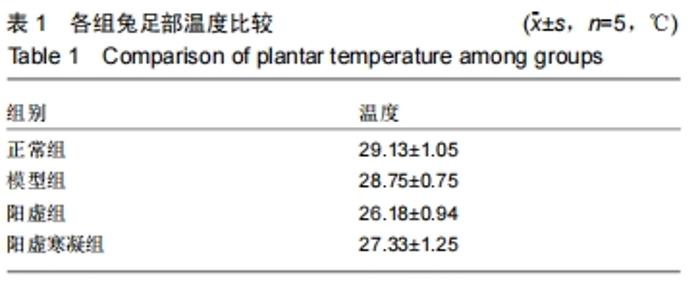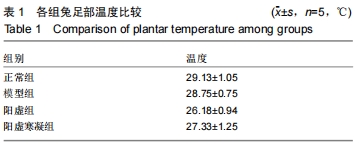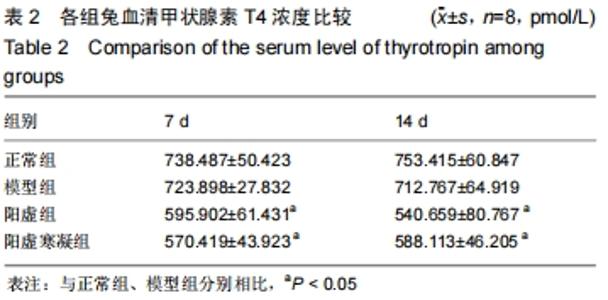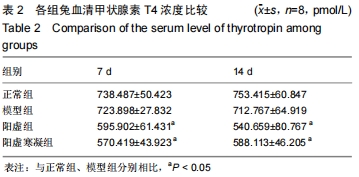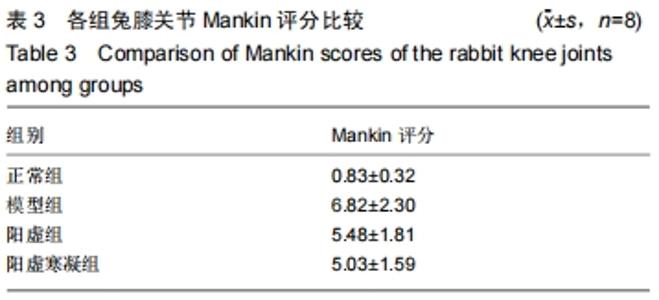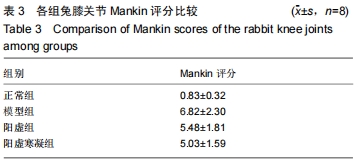[1]于建伟,李慧英,汪利合,等.中药熏洗加中药封包联合关节腔内注射玻璃酸钠治疗膝骨关节炎临床观察[J].风湿病与关节炎,2015, 4(2):10-12.
[2]沈明球,刘俊昌,王新军,等.新疆北疆牧区维、哈、汉族膝骨性关节炎致病因素的流行病学调查[J].中国组织工程研究, 2015, 19(29): 4614-4618.
[3]王新军,刘俊昌,木合塔尔·阿尤甫,等.新疆北疆牧区不同民族居民膝骨性关节炎患病现状调查[J].中国公共卫生,2015,31(7): 853-855.
[4]刘俊昌,木合塔尔·阿尤甫,王新军,等.新疆北疆牧区维吾尔族、哈萨克族及汉族膝骨性关节炎人群的中医体质特点调查[J].中华中医药杂志,2015(11):4157-4160.
[5]ROACH HI, AIGNER T, SODER S, et al. Pathobiology of osteoarthritis: pathomechanisms and potential therapeutic targets.Current Drug Targets.Curr Drug Targets. 2007;8(2): 271-282.
[6]摆雪,刘俊昌,王新军,等.膝痹膏摩法对膝骨性关节炎兔血清IL-6、IL-1β、TNF-α水平的影响[J].吉林中医药, 2018,38(4): 435-438.
[7]赖鹏华,王彦晖,何宽其,等.人工气候箱在“六淫”研究中的应用[J].中医杂志,2014,55(12):1071-1073.
[8]刘欣,崔一然,刘小青,等.右归丸干预薄荷油诱导大鼠阳虚状态的研究[J].中药材, 2015,38(8):1702-1704.
[9]李巍,冼呈,赵劲民,等,骨髓间充质干细胞移植联合川芎嗪膝关节腔注射治疗兔膝关节骨关节炎[J].中国组织工程研究,2019, 23(5):668-672.
[10]王丽娟,史晓伟,张伟,等.针刀干预对膝骨关节炎兔股四头肌肌腱拉伸力学的影响[J].中国骨伤, 2019,32(5):462-468.
[11]沈梅芳,李小萌,单琪媛.薄荷化学成分与药理作用研究新进展[J].中华中医药学刊,2012,30(7):1484-148.
[12]温亚娟,项丽玲,苗明三.薄荷的现代应用研究[J].中医学报,2016, 31(12):1963-1965
[13]梁呈元,李维林,张涵庆,任冰如.薄荷化学成分及其药理作用研究进展[J].中国野生植物资源,2003,22(3):9-12.
[14]栾世杰.薄荷寒热药性考辨[J].环球中医药,2013,6(8):610-612.
[15]何书芬,居文政,胡浩彬,等.糖皮质激素诱导肾阳虚抑郁症动物模型研究进展[J].中国实验动物学报,2016,24(6):659-665.
[16]陈颖颖,罗静,徐愿,等.肾阳虚动物模型造模方法评价及进展[J].中华中医药学刊,2018,36(11):2697-2700.
[17]熊俊慧,薛静,丁振华,等.糖皮质激素类药物联合治疗类风湿性关节炎患者的疗效及安全性评价[J].中国医院药学杂志,2016, 36(18): 582-1585.
[18]李爽,杨旭玲.小剂量糖皮质激素治疗对类风湿性关节炎患者基质金属蛋白酶3(MMP-3)水平的影响[J].实用药物与临床,2019, 22(8): 813-815.
[19]王琪珊,王婷玉.糖皮质激素在类风湿性关节炎中的作用研究进展[J].中国药理学通报,2018,34(12):1647-1651
[20]刘代华,梁健成,谢玲,等.临床药师对长期使用糖皮质激素患者的药学监护[J].中国医院药学杂志,2013,33(15):1283-1285.
[21]陈小野,周永生,樊雅莉,等.大鼠虚寒证模型的研制[J].中国实验动物学报,2001,9(3):155-159.
[22]樊雅莉,张宇鹏,蒋小丽,等.大鼠虚寒证模型部分指标相关性的初步研究[J].实验动物科学与管理,2003,20(1):4-6.
[23]詹文彦,张军华.慢性肾衰的中医辩证分型与血清生化指标的关系[J].临床医药文献电子杂志,2017,4(66):12895-12896.
[24]郑龙飞,韩玲,郝宇,等.金匮肾气丸加味膏、汤方干预肾阳虚模型大鼠的药效学对比研究[J].北京中医药大学学报, 2018,41(7): 567-571.
[25]陈英华,孙琪,欧阳轶强,等.肾阳虚证动物模型造模方法综述[J].中华中医药杂志,2003,18(6):370-372.
[26]卢文丽,方肇勤.阳虚证动物模型的造模方法与评析[J].上海中医药大学学报,2004,18(4):44-48.
[27]崔一然,刘小青,刘欣,等.薄荷油诱导大鼠类阳虚状态的实验研究[J].中华中医药杂志, 2011,26(8):1801-1804.
[28]KELLOGG DL. In vivo mechanisms of cutaneous vasodilation and vasoconstriction in humans during thermoregulatory challenges. J Appl Physiol (1985).2006;100(5):1709-1718.
[29]DEKKER J, VAN DIJK GM, VEENHOF C. Risk factors for functional decline in osteoarthritis of the hip or knee.Curr Opin Rheumatol.2009;21(5):520-524.
[30]MASUKO K, MURATA M, SUEMATSU N, et al. A metabolic aspect of osteoarthritis:lipid as a possible contributor to the pathogenesis of cartilage degradation.Clin Exp Rheumatol. 2009;27(2):374-353.
[31]TAKAHASHI D,I WASAKI N, KON S, et al. Down-regulation of cathepsin K in synovium leads to progression of osteoarthritis in rabbits.Arthritis Rheum. 2009;60(8):2372-2380.
[32]张冀东,何清湖,孙涛.红外热成像技术在中医体质研究的现状浅析[J].中华中医药杂志, 2015,30(5):1406-1409.
[33]ALTINDAG O, EREL O, AKSOY N, et al. Increased oxidative stress and its relation with collagen metabolism in knee osteoarthritis.Rheumatol Int. 2007;27(4):339-344.
[34]SUANTAWEE T, TANTAVISUT S, ADISAKWATTANA S, et al. Oxidative stress, vitamin e, and antioxidant capacity in knee osteoarthritis.J Clin Diagn Res. 2013;7(9):1855-1859.
[35]SHE GM, XU C, LIU B, et al. Polyphenolic Acids from Mint (the Aerial of Mentha haplocalyx Briq.) with DPPH Radical Scavenging Activity.J Food Sci. 2010;75(4):C359- C362.
[36]YOUSFI M, BOMBARDA I, OUINTEN M, et al. Chemical Composition, Antioxidant and Antimicrobial Activities of the Essential Oils of Three Algerian Lamiaceae Species.BMC Complement Altern Med. 2018;18(1):201.
[37]李祥,邢文峰.薄荷的化学成分及临床应用研究进展[J].中南药学, 2011,9(5):362-365.
[38]张继东,王庆琪.薄荷残渣中化学成分及抗炎作用[J].药学研究, 2000(3):34-35.
[39]苑如,王喆,宋小莉,等.薄荷油乳剂经皮给药对小鼠耳肿胀的保护作用[J].山东中医杂志, 2014,(4):296-298.
[40]乔天阳,王阿美,刘文兰.中医虚证动物模型的建立和评价[J].浙江中医药大学学报,2017,41(11):923-927+940.
|
